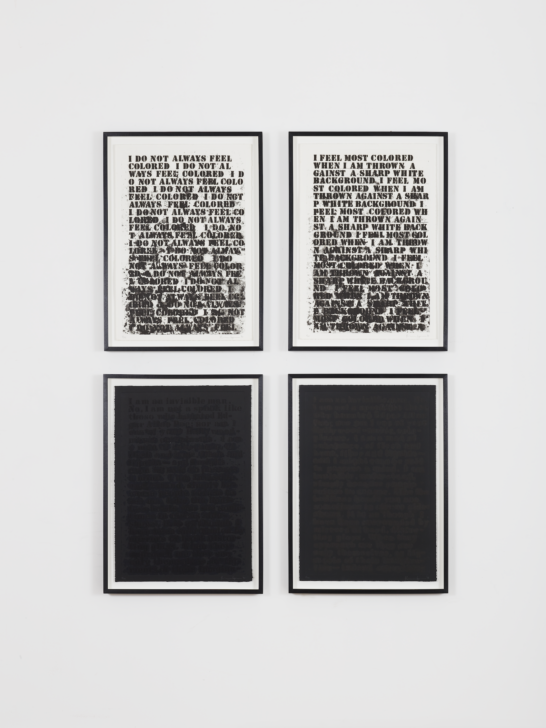Untitled
Glenn Ligon; Gregory Burnet

Description
March 28, 2009
Employing texts borrowed from sources ranging from anonymous slave narratives to Richard Pryor’s 1970s stand-up comedy routines, Glenn Ligon explores the role of language in the social and cultural construction of black identity. The first two etchings in this untitled suite repeat
a pair of sentences from Zora Neale Hurston’s landmark
1928 essay “How It Feels to Be Colored Me” in which Hurston describes color as something that is separate from her sense of self, acquiring meaning only in relation to when and how she is seen by others. In the other two etchings—printed black-on-black—Ligon draws upon a passage from Ralph Ellison’s 1952 novel The Invisible Man. Speaking about this work, Ligon has remarked that “…Ellison uses the metaphor of invisibility to describe the position of blacks in this country, as ghost, present and real but because of the blindness of racism, unseen. [My] prints work with this idea of invisibility by making the viewer strain to read the text, but making the text, through embossing, have a lot of physical presence.”
Subject Matter:
One of a suite of four etchings, this work quotes the Harlem Renaissance writer Zora Neale Hurston's 1928 essay "How It Feels to be Colored Me." In it, Hurston described how she first became aware of her Blackness when she left her "Negro town of Eatonville, Florida" in the early 1900s to go to school in Jacksonville, FL. Hurston's Blackness is seen by others as a defining and negative characteristic, and she is forced to "feel [her] race." Nevertheless she has positive feelings about her identity, and defiantly embraces her complete identity which is much more expansive than her race. She can be her whole self, without constantly being aware of what it means to be Black in America, until she is made aware of it by others; Hurston's essay also refers to code-switching. This is just one of a larger series of works that incorporate text and literature. Ligon's work does not exclusively cite texts by African Americans, but instead he appropriates a wide variety of source material in order to bring attention to the connections and relationships between his own history and collective experience.
Physical Description:
Four prints displayed in two rows. The upper right print has rows of stencilled black text in all capital letters on white background. In pencil, the print is signed and dated (l.r.) "Glenn Lignon '92" and numbered (l.l.) "27/45".
Usage Rights:
If you are interested in using an image for a publication, please visit https://umma.umich.edu/request-image/ for more information and to fill out the online Image Rights and Reproductions Request Form.